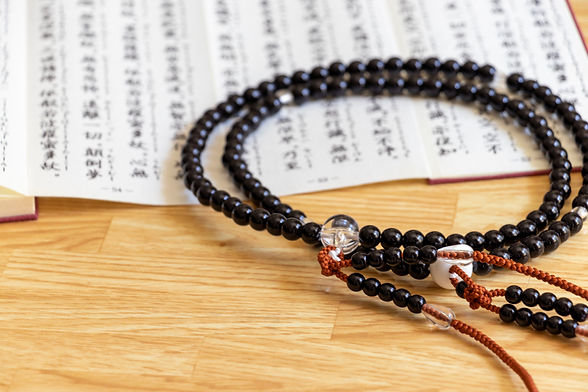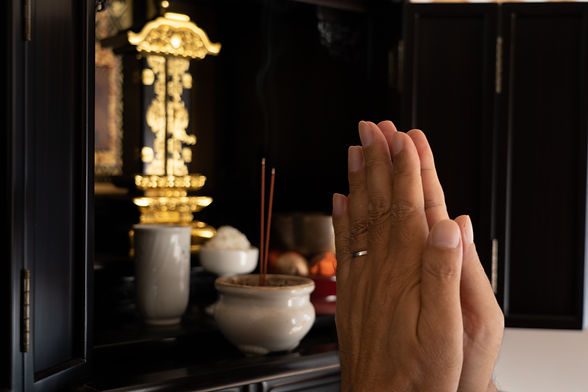
About Jodo Sect
The principal object of worship
Amida Nyorai Ryuzo
2 flanking attendant to the main deity of veneration in a temple
Kannon bosatsu, Seishi bosatsu
The Jodo sect was founded by Honen Shonin in 5th year of the Shoan era (1175). This is the teaching that even in the midst of difficult ascetic training and difficulty in chanting sutras, if one believes in the mercy and power of Amida and chants aloud "Namuamida butsu" and "Onenbutsu", one will surely receive Amida's blessings and live a peaceful life, leave the Rokudou rinne (endless circle of transmigration in the 6 posthumous worlds), and be born in Amida's Gokuraku jodo (Land of Paradise).
Onenbutsu is to chant aloud "Namuamida butsu".
"Namu" means "take refuge in the Buddhism, Thank you in advance, Please help me". "Amida butsu" means "Amida nyorai" or "Amida-sama".
Honen Shonin, the originator of Onenbutsu, who founded the Jodo sect, was shown in the "Kanmuryojukyosho" by Zendotaishi in China
"Isshinsennenmidamyogo Gyojuzagafumonjisetsu kugon Nennenfushashazemyoushojojigo Junpibutsu ganko"
"The path to rebirth is to praise the name of Mida with all one's heart, always and everywhere, regardless of whether the time is short or long, and always keep this in mind.The reason for this is to follow the original vow of Mida".
With these words, he chose the path of dedicated Nenbutsu, descended from Mt. Hiei, and spread the teachings of the Onenbutsu.
The sutra on which the Jodo sect is based is "the Jodo Sanbukyo (Muryo jukyo, Kanmuryo jukyo, Amidakyo)".
-
Muryo jukyo (2 volumes): It describes Amidabutsu's original wish for the salvation of sentient beings during his ascetic training period, and the benefits that will come after that wish is fulfilled.
-
Kanmuryo jukyo (1 volume): It describes in detail the method of rebirth in Gokuraku jodo (Land of Paradise) for Idaikebunin, a queen of Rajagriha during the Shakuson era.
-
Amidakyo (1 volume): It explains what kind of place Gokuraku jodo is.
The Gokuraku jodo is Buddhism eternal paradise to the west, the Buddhas of the 6 directions have proven the correctness of the teachings of Nenbutsu, and it is said that Amidabutsu is currently preaching there and protecting the practitioners.It is also said that the reason a country is called Gokuraku (paradise) is that the people in that country experience no suffering, only happiness.


Onenbutsu
(Buddhist chant)
If you simply chant the "mina (name)" of Amidabutsu with all your heart, Amidabutsu will guide all those who call upon his name to rebirth in the Gokuraku jodo.
"Namu" means "thank you in advance" or "I leave everything to you".
"Amida" means "muryoju (infinite life)" and "muryoukou (infinite blessings)". It is the Buddha of eternal life who, after completing immeasurable ascetic training, illuminates us equally with the light of salvation that is beyond our comprehension as small beings. The Onenbutsu of "Namuamidabutsu" has the meaning of "Amida, please save me even though I am not good enough. Thank you very much". The Onenbutsu also includes the feeling of offering a memorial service to one's ancestors and those who have passed away. Let us chant it as part of our daily practice.


Ojunen
One method of chanting the Onenbutsu is called "Ojunen".
The way to chant is to say "Namuamidabutsu" 4 times, then take a breath and repeat it 4 more times. After taking another breath, say "Namuamidabutsu" for the 9th time. For the final, 10th time, bow your head while slowly saying "Naamuamidabu".


Ojuzu
(prayer beads)
Carry Ojuzu when you visit the Buddhist altar daily, visit graves, and attend funerals and memorial services.
Ojuzu are Buddhist utensils used to count the number of Onenbutsu recitations. Also called Onenju, the Jodo sect usually uses 2 rows of Ojuzu. Usually, it is worn on the left wrist, and when praying, 2 rows of Ojuzu are lined up, placed between the thumbs of both hands, and draped toward the front.


Gassho
(palms together)
Gassho is an ancient Indian gesture of respect for others, which is used in Buddhism when worshipping the Buddha or ancestors.
Align your fingers together in front of your chest and press your palms tightly together. Hold them diagonally at a 45 degree angle. This is called "kenjitsushin gassho".

